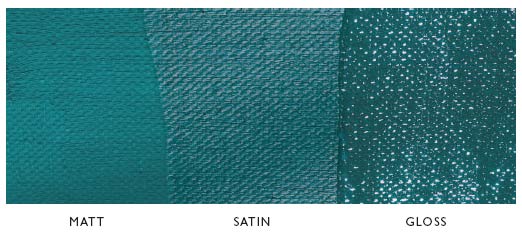£5 OFF Orders over £50 | Use Code 585C
Artisan mediums
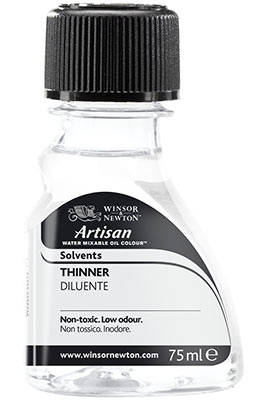
As with conventional oil painting, mediums allow you to alter the characteristics and working properties of your tube colour. Artisan has its own specially developed range of Oils, Mediums, Varnishes and a Thinner to allow all techniques to be achieved with Artisan colours
The products are:
All of these products are certified “AP Non Toxic” by the Art & Creative Materials Institute (ACMI) in the USA. All Artisan bottles are easy to open as they do not require child resistant caps.
Thinning Artisan Water Mixable Oil Colour
Thinning with Water
Water is used for thinning Artisan colours instead of the solvents used with conventional oils. Water should be added gradually, a small amount at a time and mixed well on the palette. If too much water is used or added too quickly, some colours may ‘foam' with air bubbles. This can be reduced or avoided by using Artisan Thinner or combining the water with an Artisan medium.
As water is added, some colours will lighten in tone. The colour will return to its original hue as the water evaporates. This colour change is reduced by the use of Artisan mediums in addition to water or by using Artisan Thinner instead.
Thinning with Artisan Thinner
Although water is suitable as a diluent for the colour, its speedy evaporation can make the colour thicken upon the palette much quicker than conventional oil colour would when used with turpentine.
To help with this issue we have developed a Thinner to dilute Artisan colours. This can be used instead of water or combined with it. It also provides a more oily consistency which is preferred by some painters and as it is not forming an emulsion with the colour there is less colour change than there would be when using water.
Thinner may be combined with Artisan oils to make your own mediums.
Important: Beware of over thinning. Water and Thinner thin the colour by diluting the modified linseed oil. If too much is used, there will be insufficient oil remaining to bind the pigment. The paint surface will be susceptible to damage and appear dull and matt. For fluid, transparent colour with an even sheen, dilute with Artisan Painting Medium, Artisan Fast Drying Medium, Artisan Linseed Oil, Artisan Safflower Oil or Artisan Stand Oil as well as water or Thinner. Artisan can however, be thinned right down with water or Thinner for staining a canvas in the early stages of a painting.
Characteristics
Characteristics | THINNERS | |
Thinner | Water | |
Diluting – Speed of evaporation | x1 | x2 |
Improves Flow |
|
|
Controls Flow |
|
|
Reduces Consistency |
|
|
Increases Transparency |
|
|
Speeds drying time |
|
|
Slows drying time |
|
|
Increases Gloss |
|
|
Impasto Effect |
|
|
For use with paler colours |
|
|
Oils Out |
|
|
For preparing your own mediums | X | X |
Increases durability of Film |
|
|
Picture Cleaning | X |
|
Protects finished pictures |
|
|
Removable |
|
|
Cleans Materials | X | X |
Varnish Removing |
|
|
Denotes relative speed of evaporation x1 x2 Faster
Oils for Artisan
Linseed Oil
Artisan Water Mixable Linseed Oil is the main binder in the Artisan colours. When mixed with colour it reduces consistency. Linseed oil is the most commonly used medium. It is combined with water or Thinner to maintain the structure of the paint film. It is also used when painting in layers to maintain the fat over lean rule: each successive layer must have more oil in it than the previous one.
Safflower Oil
As it is a paler yellow, the paler pigments maintain their brightness. If painting a lot with pale colours, you may choose to use Artisan Water Mixable Safflower Oil instead of Linseed Oil to reduce their consistency. It also increases gloss and transparency. Safflower Oil is slow drying and should not be used under faster drying layers, e.g. Fast Drying Medium, umbers etc.
Stand Oil
Stand Oil is ideal for glazing & fine details as it gives a smooth enamel effect finish with no brush marks. It also increases film durability.
Characteristics
Characteristics | OILS | ||
Linseed Oil | Safflower Oil | Stand Oil | |
Diluting – Speed of evaporation |
|
|
|
Improves Flow |
|
| X |
Controls Flow |
|
|
|
Reduces Consistency | X | X | X |
Increases Transparency | X | X | X |
Speeds drying time |
|
|
|
Slows drying time |
| X | X |
Increases Gloss | X | X | X |
Impasto Effect |
|
|
|
For use with paler colours |
| X |
|
Oils Out |
|
|
|
For preparing your own mediums | X | X | X |
Increases durability of Film |
|
| X |
Picture Cleaning |
|
|
|
Protects finished pictures |
|
|
|
Removable |
|
|
|
Cleans Materials |
|
|
|
Varnish Removing |
|
|
|
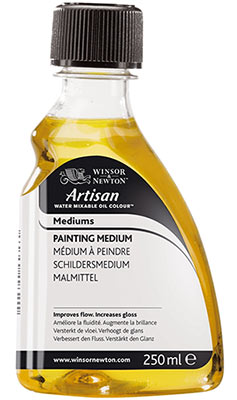 Artisan Mediums
Artisan Mediums
Artisan Painting Medium is a stand oil based medium, ready made from the bottle. Because of the complex chemistry of water mixable oils, it has been possible for us to formulate a superior medium from a selection of raw materials. This medium thins the consistency of Artisan oil colours and aids fine detail work. It also improves the flow and wetting of the colour. It dries slowly to a flexible film and is good for "oiling out". Oiling out is the application of an oil medium to a painting which has sunk, or lost its oil to the layer underneath.
Fast Drying Medium is a very popular medium as it speeds the drying of oil colour by about 50%, allowing further layers to be applied more quickly. The formulation has been improved and this has helped to wet the colour better. It thins the colour and increases gloss and transparency. When painting in layers it can substitute linseed oil and be combined with water and/or Thinner to maintain fat over lean.
Impasto Medium is a water mixable impasto and texturing medium for use with Artisan oil colours. It will maintain the tube consistency of the colour and speeds the drying of the colours by about 50%. For thick impasto, build the texture in several layers allowing each layer to dry first, mixing the impasto thoroughly into the colour before use.
Amount of Medium Used
Mediums are additives and as such should be used in modest proportions, just enough to achieve the desired result. Too much Artisan Linseed Oil or Stand Oil will lead to wrinkling of the surface, just as it would with conventional oils.
Mixing Artisan Mediums
Artisan Mediums can be mixed together. If you do want to modify any of the mediums by mixing them do so thoroughly and stir before every use.
Making Your Own Mediums to Use with Artisan Colour
Many people mix linseed oil and solvent together whilst painting with conventional oils. You can add do this with Artisan by adding Thinner to Artisan Linseed Oil, Safflower Oil or Stand Oil. If you do make your own medium, mix the components thoroughly and stir every time before use.
Characteristics
Characteristics | MEDIUMS | ||
Painting Medium | Fast Drying Medium | Impasto Medium | |
Diluting – Speed of evaporation |
|
|
|
Improves Flow | X |
|
|
Controls Flow |
| X |
|
Reduces Consistency | X | X |
|
Increases Transparency | X | X |
|
Speeds drying time |
| X | X |
Slows drying time | X |
|
|
Increases Gloss | X | X |
|
Impasto Effect |
|
| X |
For use with paler colours |
|
|
|
Oils Out | X |
|
|
For preparing your own mediums |
|
|
|
Increases durability of Film | X |
|
|
Picture Cleaning |
|
|
|
Protects finished pictures |
|
|
|
Removable |
|
|
|
Cleans Materials |
|
|
|
Varnish Removing |
|
|
|
Varnishes
Varnishing Artisan Paintings
Varnishes provide a transparent coating which protects your finished painting from general dirt. Picture varnishes are removable, enabling the painting to be cleaned in the future. Varnishes should not be used as mediums for adding to the colour. Artisan paintings should not be varnished until thoroughly dry (at least 6 months). There are three Artisan varnishes available: Gloss Varnish, Matt Varnish, Satin Varnish depending upon the desired finish.
Gloss Varnish Matt Varnish Satin Varnish Varnish Remover
|
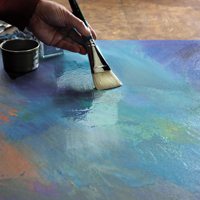
Applying the Varnish
The painting will benefit from being degreased before varnishing. This can be done with either Artisan Thinner or Artists' White Spirit (mineral spirits). Simply wipe over the surface of the picture sparingly and leave to dry overnight.
Apply the varnish using a large dry varnishing brush, immerse the brush in the chosen varnish and apply in long steady strokes across the painting surface.
To ensure the desired result, test before use. Matt and Satin should be shaken or stirred well before use and should not be used on absorbent or damaged surfaces.
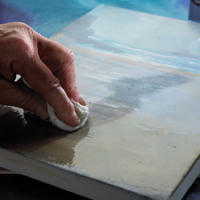
Removing Varnish
Artisan Varnish can be readily removed when dirty. To remove Artisan Gloss, Matt or Satin Varnish, apply the Varnish Remover generously onto a lint free cloth and gently rub into the varnish film. If slight pigment is visible on the cloth this is an indication that the removal has been successful. Use plenty of clean cloth to ensure varnish is being removed from the surface. Avoid undue abrasion.
Characteristics
Characteristics | VARNISHES | |||
Gloss Varnish | Matt Varnish | Satin Varnish | Varnish Remover | |
Protects finished pictures | X | X | X |
|
Removable | X | X | X |
|
Cleans Materials |
|
|
|
|
Varnish Removing |
|
|
| X |
See our range of Artisan Mediums












